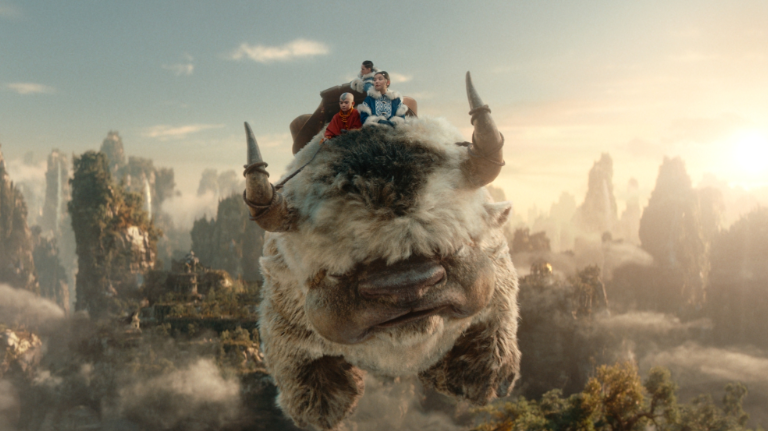At first glance, Nickelodeon’s original “Avatar: The Last Airbender” is just a kids show, but something about the cartoon unsuspectedly captured the hearts of many in the late 2000s. The show solidified itself as a cult classic with its well-crafted narrative, blending action and poignancy through a cast of relatable characters. Nickelodeon remarkably pushed the envelope for children’s animation with its masterful worldbuilding and ability to touch on complex and nuanced themes.
After years of anticipation and little news surrounding the project since its announcement in 2018, “Avatar: The Last Airbender” returned in an eight episode Netflix adaptation on Feb. 22, covering “Book One: Water” of the original show. The show was an instant hit, topping the weekly global Netflix chart from Feb. 19-25 despite garnering mixed opinions from fans and critics due to controversies surrounding the original creators of the cartoon, Michael Dante DiMartino and Bryan Konietzko, departing the project over creative differences.
The “Avatar: The Last Airbender” adaptation opens with a sinister flashback to the start of the Hundred Year War during the Air Nomad Genocide, a massacre that was caused by the Fire Nation in hopes of taking down the Avatar, the only person able to master all four bending elements (water, earth, fire, and air) and stop the Fire Nation’s campaign for world domination. After a time skip, we are introduced to Aang (Gordon Cormier), the twelve-year-old Avatar and last living Airbender who is found preserved in an iceberg 100 years later by two teenage siblings from the Southern Water Tribe, Sokka (Ian Ousley) and Katara (Kiawentiio). The series follows Aang’s journey to mastering all four elements and restoring balance to the world, with Katara, Sokka, and Appa (his flying bison) as his companions.
Unlike the original cartoon, Netflix’s adaptation of “Avatar: The Last Airbender” takes a more formidable approach to the story, highlighting the violence from the Fire Nation by capturing the world in a war-torn state and showing the events before and after the Air Nomad Genocide. The plot picks up quickly, with action and fight scenes that authentically depict the real-life martial arts disciplines the show is inspired by. Breathtaking visual effects capture the scenery of the four nations and various fantastical animals, bringing the world from the cartoon to reality.
It’s undoubtedly clear that the producers were determined to create an adaptation that is authentic and enjoyable for both long-time and new fans, staying true to the show’s original premise and fleshing out the previews with fantastic casting, action, and costumes. As a long-time fan of the original cartoon, I initially had high hopes for this adaptation, but Netflix missed the mark in capturing the essence of the beloved cartoon.
Although the show has a similar runtime to the first season of the original cartoon, its story is split up to longer episodes where episodes from the original show are combined together, resulting in a story that feels rushed. Many additional scenes and dialogue changes felt like pointless filler and repetition of exposition that wasted valuable screen time and confused the overall storyline. The show instead spends excessive time developing separate storylines between Team Avatar, Zuko and the Fire Nation. In the process, Netflix completely misses the point of the first season of the original cartoon, which was for Aang to master waterbending.
The most detrimental failure of this adaptation was the lack of synergy between the characters due to the show’s poor writing and pacing, which the original cartoon nailed through shorter episodes that showcased more varied storylines and connections between the characters with the added downtime apart from the main action. Many of the interactions between the characters in the adaptation felt wooden, with overly straightforward dialogue that felt repetitive and lifeless.
I also felt that the characters in the adaptation had their personalities stripped away, due to many of their defining or interesting traits being removed to either accommodate for the changed story or avoid controversy. One of my favorite things about the original cartoon was how each character was able to be flawed, yet grow throughout their respective journeys and have depth through their past traumas. The characters in the adaptation had no growth during the first season, which made them uninteresting and unrelatable.
The show succeeded in bringing together a community of fans again despite its criticism, and although I wanted to enjoy an adaptation that complements the beloved Nickelodeon cartoon, it ultimately struggled to deliver on my nostalgia and could’ve been better executed if the original creators stayed. The adaptation is far from perfect but it pays homage to its source material while completely reimagining the fantastical elements from the cartoon with its standout cinematography, visual effects, and action. Whether you’re a long-time fan or are new to the franchise, Netflix’s “Avatar: The Last Airbender” is a visually captivating, well-produced show that’s worth watching.


Dev • Apr 5, 2024 at 10:24 am
This is truly inspirational alice. Keep it up, congrats on the Nobel Prize!